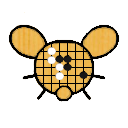For such a large dragon and such a big loss giving up any side, I feel a human would almost certainly opt to take the ko. And for black to invest so many moves setting up a kill, I also feel black can not afford to back off either.
The question is how would the ko progress? I seriously have no idea. There are quite a bit of local threats as well as the whole right side for white, and quite a bit of local threats for black and some on the lower left. It’s really up in the air and hard to judge (and their value also quite hard to judge). White can not afford to lose this ko though, but it can possibly switch to other ko as well.


Can you show the variations for this poking?